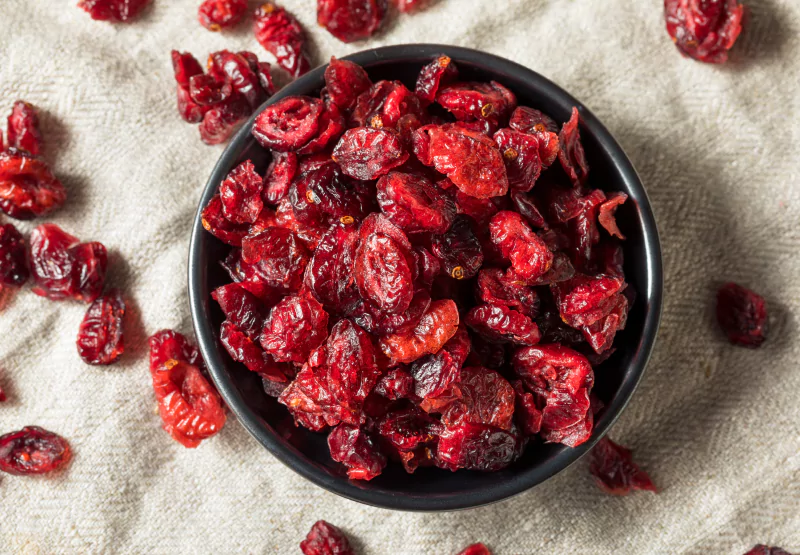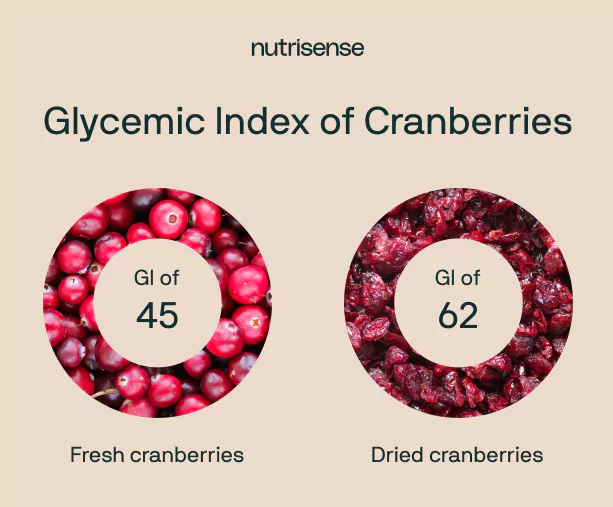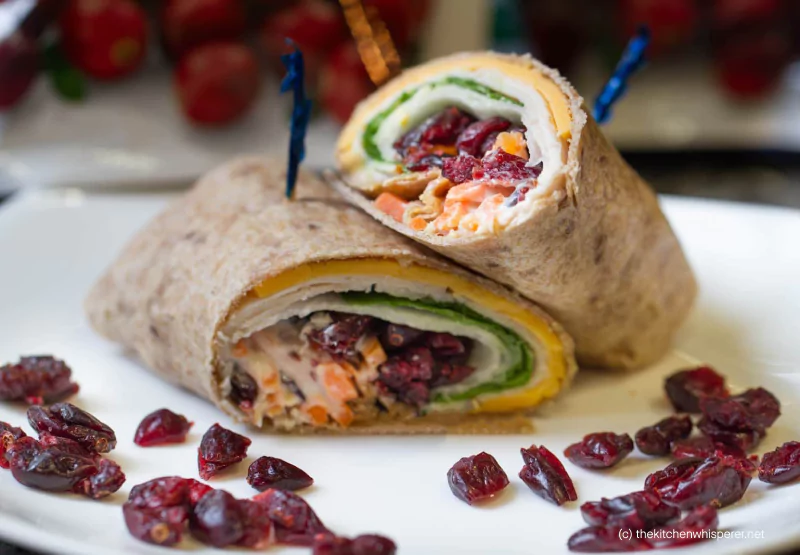Dried Cranberries: Nutrition, Health Benefits, and More

Key Takeways
You may think of cranberries as a delicious holiday fruit. While fresh cranberries are harvested in the fall, these nutritious berries are also available year-round in other forms!
Not only are these berries a great addition to any parfait or savory dish, they may also support gut and urinary tract health, and may even help prevent heart disease.
Wondering what kinds of benefits cranberries may have and how you should be eating them for maximum health benefits?
Here’s a closer look at the nutritional value of cranberries, including their impact on:
- Blood sugar
- Cardiovascular health
- Urinary tract health
Nutritional Content of Cranberries
Cranberries are often used as a pie filling or served as cranberry sauce to pair with turkey or ham. But they can also be enjoyed fresh, dried, and even in the form of cranberry juice.
You may be familiar with cranberry-themed brands like Ocean Spray or Craisins. Cranberries are incredibly versatile—these berries grow on bushes belonging to the Ericaceae family, along with azaleas, rhododendrons, and blueberries.
But are all types of cranberries good for you? Here’s what you need to know about the nutritional content of these berries.
Dried Cranberries
Dried cranberries have been dehydrated and are typically eaten on their own, mixed into salads or trail mixes, or used in baking. Because this fruit is so tart and acidic, dried cranberries are typically sweetened with sugar or a sugar alternative.
One half cup of dried cranberries contains:

Because they’ve been dehydrated, dried cranberries are higher in sugar, containing 58 grams per half cup. They are a good source of dietary fiber, containing 4.2 grams, which is 17 percent of your daily recommended value.
A half cup of cranberries also contains 40 milligrams of potassium, 1.7 percent of your daily value of iron, and small amounts of vitamin C and vitamin A.
Fresh Cranberries
Fresh cranberries are tart and bitter when eaten raw, which is why they are often included in baked goods and other sweetened meals. One half cup contains:

With two grams of fiber in just a cup, they provide eight percent of your daily recommended value of fiber. They have much less sugar than dried cranberries, with only 2.4 grams.
One half cup also contains 44 milligrams of potassium and small amounts of vitamin C, vitamin A, and iron.
Cranberry Juice
Cranberry juice is a popular drink at all times of year, and is often used in many classic cocktails. It’s also well-known for addressing urinary tract infections.
One half cup, or four ounces, of cranberry juice contains:

Cranberry juice is the lowest in fiber compared to fresh or dried cranberries, with only 0.1 grams. It’s also relatively high in sugar, with 11.9 grams per half cup.
A half cup serving also contains 90.1 milligrams of potassium, 62.2 percent of your daily recommended value of vitamin C, and 0.6 percent of your daily value of vitamin A.
Health Benefits of Cranberries
Because of their nutritional density and their antioxidant content, there are a number of health benefits of dried cranberries and other forms of this delicious berry. Here are four reasons why you may want to add more cranberries to your diet.
1) May Improve Cardiovascular Function
Eating cranberries may be good for your heart health. A recent study had 45 healthy men eat the equivalent to 100 grams of fresh cranberries or a placebo every day for one month.
The participants who ate the cranberry powder showed significant improvements in flow-mediated dilation, or FMD, which measures how blood vessels widen when blood flow increases.
Impaired FMD is associated with an increased risk of cardiovascular disease, while a healthy FMD is a mark of good heart and blood vessel function.
Fresh and dried cranberries are also a good source of potassium, which can help lower blood pressure and reduce the risk of heart disease.
2) Can Help Prevent Urinary Tract Infections

Cranberry juice is often recommended as a natural remedy for the prevention of UTIs, and there is some evidence it may actually work: research does indeed suggest that cranberry juice may decrease the number of symptomatic UTIs.
One study tested cranberry juice and cranberry tablets versus a placebo in women between the ages of 21 to 72 years. Of the groups:
- 32 percent of the placebo group contracted a UTI over the study period
- 20 percent of the cranberry juice group contracted a UTI
- 18 percent of the cranberry tablets group contracted a UTI
At this time, the recommended dose of cranberry products for the prevention of UTIs is still poorly defined. More research is needed to determine whether cranberry juice can prevent UTIs, and what dose is effective.
3) Have Antioxidant Properties
Cranberries are rich in high-quality antioxidants, including flavonoids, catechins, and phenolic acids. It’s important to note, however, that the antioxidant content can vary between dried cranberries, cranberry juice, and fresh cranberries.
The antioxidants in cranberries may reduce inflammation, increase nitric oxide synthesis (which is necessary for many important functions, including insulin secretion), positively affect cholesterol levels, combat free radicals, and prevent cellular damage.

Cranberries are also high in polyphenols, which have antioxidant properties. The proanthocyanidins in dried cranberries may help promote healthy blood lipid levels and help fight against UTIs.
Animal studies suggest that the polyphenols in cranberry juice can increase the levels of antioxidant capacity in organs, which may contribute to a lower risk of chronic diseases. Notably, polyphenols from cranberry juice accumulate in the kidney and bladder, which may explain their purported benefits to the urinary tract.
4) May Help Prevent Tooth Decay
Research shows that the anthocyanins in cranberries can help prevent tooth decay.This may be due to the anti-adhesive and anti-microbial properties of these compounds.
More research may still be needed to investigate the benefits of cranberries for oral health.
Dried Fruits and Your Blood Sugar

Dried cranberries contain many of the same nutrients and antioxidants as fresh cranberries. They both contain similar amounts of fiber, vitamins, potassium, and iron.
The main nutritional difference between fresh and dried cranberries is their sugar content. Dried cranberries often contain added sugar to make up for their natural tartness.
However, some studies show that these foods may not necessarily spike blood sugar for everyone.
Dried cranberries count towards your daily recommended fruit consumption, which is 1½ to two cups daily for women and two to 2½ cups for men. The U.S. Department of Agriculture notes that a half cup of dried fruit is equal to a full cup of fresh fruit.
Some studies have shown that dried fruits have no significant effect on fasting glucose, though others have shown a small elevation in fasting glucose. Eating dried fruits with a source of protein or fiber may help reduce the risk of spikes in blood sugar.
Do Cranberries Raise Your Blood Sugar?

Dried cranberries are a medium-GI food, meaning they may have an effect on your blood sugar.
The glycemic index, or GI scale, assigns a number to certain foods according to how quickly sugar from food will enter your bloodstream, causing a spike in blood sugar.
Here’s what the glycemic index scale looks like:
- A score of 1 to 55 is considered a low-GI
- 56 to 69 is a medium-GI
- Higher than 70 is a high-GI
Dried cranberries have a GI of 62, while fresh cranberries have a low-GI of 45. This is because of the higher sugar content of dried cranberries. Whether or not dried cranberries affect your blood sugar will probably depend on the quantity you eat, and what kind. Glycemic response always needs to take into consideration the amount of a given food, also considered the glycemic load.
One study compared the glycemic response in people with type 2 diabetes after eating white bread, fresh cranberries, sweetened dried cranberries, and dried cranberries with less sugar.
The dried cranberries with less sugar were associated with a positive glycemic and insulin response in the participants, suggesting that avoiding added sugar in dried cranberries may help you avoid blood sugar spikes.
Are There Any Side Effects of Eating Cranberries?
Some research has shown that eating cranberries - specifically drinking cranberry juice - may lead to kidney stones in some people. If you have a history of kidney stones or related conditions, you may want to limit your intake of cranberries and consult your doctor or dietitian for guidance.
Excessive consumption of cranberries may also lead to upset stomach symptoms and nausea for some people.
What’s the Healthiest Way to Eat Dried Cranberries?
Here are three of our favorite healthy dried cranberry recipes to try out if you want to include more of this tasty fruit in your diet.
1) Greek Yogurt Topped with Dried Cranberries

Topping plain Greek yogurt with dried cranberries can be a great way to start the morning. Greek yogurt is high in protein and doesn’t contain added sugar, while the cranberries provide a touch of natural sweetness and antioxidants.
You can even add in some unsalted nuts, chia seeds, or nut/seed butter for a boost in healthy fats.
Ingredients
- Plain Greek yogurt (Fage brand or similar)
- Dried Cranberries
- Unsalted walnuts
- Chia seeds
Instructions
- Add a half cup of plain Greek yogurt to a bowl, top with a handful of dried cranberries, walnuts, and a sprinkle of chia seeds. Enjoy!
2) Homemade Dried Cranberries from Wholesome Yum
This homemade recipe is sweetened with monk fruit and allulose, two natural sugar substitutes that contain no calories and are less likely to affect your blood sugar.
Pair these with fiber or protein for a complete, healthy homemade trail mix.
Ingredients
- Water
- 12 ounces cranberries (fresh or frozen and thawed)
- ½ cup Besti brand powdered monk fruit/allulose blend
- 1 tablespoon avocado oil
- Walnuts or almonds (optional - to eat together)
3) Dried Cranberry and Turkey Wrap from The Kitchen Whisperer

These wraps can be a great way to use up leftover holiday turkey. You can also use keto or low-carb wraps if you follow a lower carb approach.
Ingredients
- 4 low-calorie whole grain wraps (or any wrap of your choice)
- 4 slices sharp cheddar
- 8-12 slices roasted turkey breast
- 1 cup dried cranberries
- ½ cup carrots, shaved
- ½ cup shaved jicama
- 1 cup spinach leaves
- 4 tablespoons low-fat ranch (optional)
Find the right Nutrisense programto turn insight into progress.
Go Beyond Glucose Data with Nutrisense
Your glucose can significantly impact how your body feels and functions. That’s why stable levels are an important factor in supporting overall wellbeing. But viewing glucose isn't enough. Nutrisense, you’ll be able to learn how to use your body's data to make informed lifestyle choices that support healthy living.
One-to-one coaching
Sign up to access insurance-covered video calls to work with a glucose expert: a personal registered dietitian or certified nutritionist who will help tailor your lifestyle and diet to your goals.
Monitor and measure what matters
With the Nutrisense CGM Program, you can monitor your glucose with health tech like glucose biosensors and continuous glucose monitor (CGM)s, and analyze the trends over time with the Nutrisense App. This will help you make the most informed choices about the foods you consume and their impact on your health.
Find your best fit
Ready to take the first step? Start with our quiz to find the right Nutrisense program to help you take control.

Heather is a Registered and Licensed Dietitian Nutritionist (RDN, LDN), subject matter expert, and technical writer, with a master's degree in nutrition science from Bastyr University. She has a specialty in neuroendocrinology and has been working in the field of nutrition—including nutrition research, education, medical writing, and clinical integrative and functional nutrition—for over 15 years.




